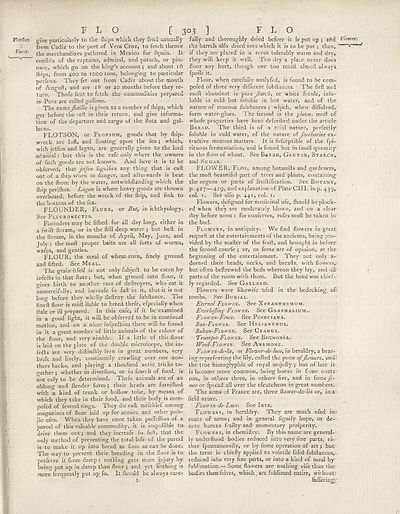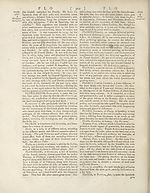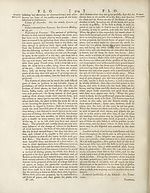Encyclopaedia Britannica > Volume 7, ETM-GOA
(329) Page 303
Download files
Complete book:
Individual page:
Thumbnail gallery: Grid view | List view

FLO [ 303 ] FLO
Flotfon give particularly to the fliips which they fend annually
!i from Cadiz to the port of Vera Cruz, to fetch thence
Flo',r' the merchandizes gathered in Mexico for .Spain. It
' v confitts of the captains, admiral, and patach, or pin¬
nace, which go on the king’s account; and about 16
{hips, from 400 to 1OOO tons, belonging to particular
perfons. They fet out from Cadiz about the month
of Auguft, and are 18 or 20 months before they re¬
turn. Thofe fent to fetch the commodities prepared
in Peru are called galleons.
The name flotilla is given to a number of (hips, which
get before the reft in their return, and give informa¬
tion of the departure and cargo of the flota and gal¬
leons.
FLOTSON, or Flotsom, goods that by {hip-
wreck are loft, and floating upon the fea; which,
with jetfon and lagan, are generally given to the lord
admiral: but this is the cafe only where the owners
of fuch goods are not known. And here it is to be
obferved, that jetfon fignifies any thing that is caft
out of a (hip when in danger, and afterwards is beat
on the fhore by the water, notwithftanding which the
{hip perifhes. Lagan is where heavy goods are thrown
overboard, before the wreck of the (hip, and fink to
the bottom of the fea.
FLOUNDER, Fluke, or But, in ichthyology.
See Pleurovectes.
Flounders may be fifhed for all day long, either in
a fwift ftream, or in the ftill deep water ; but beft in
the ftream, in the months of April, May, June, and
July : the moft proper baits are all forts of worms,
w'afps, and gentles.
FLOUR, the meal of wheat-corn, finely ground
and fifted. See Meal.
The grain itfdf is not only fubjed to be eaten by
infedts in that Hate ; but, when ground into flour, it
gives birth to another race of deftroyers, who eat it
unmercifully, and increafe fo fail in it, that it is not
long before they wholly deftroy the fubftance. The
fineft flour is mbft liable\o breed thefe, efpecially when
Itale or ill prepared. In this cafe, if it be examined
in a good light, it will be obferved to be in continual
motion, and -on a nicer infpeftion there will be found
in it a great number of little animals of the colour of
the flour, and very nimble. If a little of this flour
is laid on the plate of the double microfcope, the in-
feds are very diftin&ly feen in great numbers, very
briflc and lively, continually crawling over one ar.o-
thers backs, and playing a thoufand antic tricks to¬
gether ; whether in diverfion, or in fearch of food, is
not eafy to be determined. Thefe animals are of an
oblong and {lender form; their heads are furniftied
with a kind of trunk or hollow tube, by means of
which they take in their food, and their body is com-
pofed of feveral rings. They do vaft mifchief among
magazines of flour laid up for armies and other pub¬
lic ufes. When they have once taken pofleflion of a
parcel of this valuable commodity, it is impofiible to-
drive them out; and they increafe fo fall, that the
only method of preventing the total lofs of the parcel
is to make it up into bread as foon as can be done.
The way to prevent their breeding in the flour is to
preferve it from damp : nothing gets more jnjury by
being put up in damp than flour ; and yet nothing is
more frequently put up fo. It fhould be always care¬
fully and thoroughly dried before it is-put up ; and Uower.
the barrels alfo dried into which it is to be put ; then, —-v—"
if they are placed in a room tolerably warm and dry,
they will keep it well. Too dry a place never does
flour any hurt, though one too moift almoft always
fpoik it.
Flour, when carefully analyfed, is found to be com-
pofed of three very different fubftances. The firft and
moft abundant is pure flarch, or white fecute, info-
luble in cold but foluble in hot water, and of the
nature of mucous fubrtances ; which, when diffolved,
form water-glues. The fecond is the gluten, moft of
whofe properties have been defcribed under the article
Bread. The third is of a mild nature, perfectly
foluble in cold water, of the nature of faccharine ex¬
tractive mucous matters- It is fufceptible of the fpi-
rituous fermentation, and is found but in fmall quantity
in the flour of wheat. See Bread, Gluten, Starch,
and Sugar-
FLOWER, Flos, among botanifts and gardeners,
the moft beautiful part of trees and plants, containing
the organs or parts of fructification. See Botany,
p. 427—429, and explanation of Plate CIII. in p. 439,
col. i. See alfo p. 441, col. 1.
Flowers, defigned for medicinal ufe, fhould be pluck¬
ed when they are moderately blown, and on a clear
day before noon : for conferves, rofes muft be taken in
the bud.
Flowers, in antiquity. We find flowers in great
requeft at the entertainments of the ancients, being pro¬
vided by the mailer of the feail, and brought in before
the fecond courfe ; or, as fome are of opinion, at the
beginning of the entertainment. They not only a-
dorned their heads, necks, and breads, with flowers,
but often beftrewed the beds whereon they lay, and all
parts of the room with them. But the head was chief¬
ly regarded. See Garland.
Flowers were likewife ufed in the bedecking, of
tombs. See Burial.
Eternal Flower. See Xeranthemum.
Everlafling Flower. See Gnaphalium.
FlowER-Fence. See Poinciana.
Suh-Flower. See Helianthus.
Sultan-pLowER. See Cyan us.
Trumpet-Flower. See Bignonia.
Wind-Flower- See Anemone.
FiowER-de-lis, or Flower-de-luce, in heraldry, a bear¬
ing reprefenting the lily, called the queen of flowers, and-
the true hieroglyphic of royal majefty ; but of late it
is become more common, being borne in fome coats
one, in others three, in others five, and in fomefe-
mee or fpiead all over the efcutcheon in great numbers.
The arms of France are, three fiower-de-lis or, in a
field azure.
Flower-de-Luce. See Iris.
Flowers, in heraldry. They are much ufed m;
coats of arms; and in general fignify hope, or de¬
note human frailty and momentaiy profperity.
Flowers, in chemiftry. By this name are general¬
ly underftood bodies reduced into very fine parts, ei¬
ther fpontaneoufly, or by fome operation of art; but
the term is chiefly applied to volatile folid fubllances,
reduced into very fine parts, or into a kind of meal by
fubbrnation.— Some flowers are nothing elfe than the
bodies themfelves, which are fublimed entire, without
Flotfon give particularly to the fliips which they fend annually
!i from Cadiz to the port of Vera Cruz, to fetch thence
Flo',r' the merchandizes gathered in Mexico for .Spain. It
' v confitts of the captains, admiral, and patach, or pin¬
nace, which go on the king’s account; and about 16
{hips, from 400 to 1OOO tons, belonging to particular
perfons. They fet out from Cadiz about the month
of Auguft, and are 18 or 20 months before they re¬
turn. Thofe fent to fetch the commodities prepared
in Peru are called galleons.
The name flotilla is given to a number of (hips, which
get before the reft in their return, and give informa¬
tion of the departure and cargo of the flota and gal¬
leons.
FLOTSON, or Flotsom, goods that by {hip-
wreck are loft, and floating upon the fea; which,
with jetfon and lagan, are generally given to the lord
admiral: but this is the cafe only where the owners
of fuch goods are not known. And here it is to be
obferved, that jetfon fignifies any thing that is caft
out of a (hip when in danger, and afterwards is beat
on the fhore by the water, notwithftanding which the
{hip perifhes. Lagan is where heavy goods are thrown
overboard, before the wreck of the (hip, and fink to
the bottom of the fea.
FLOUNDER, Fluke, or But, in ichthyology.
See Pleurovectes.
Flounders may be fifhed for all day long, either in
a fwift ftream, or in the ftill deep water ; but beft in
the ftream, in the months of April, May, June, and
July : the moft proper baits are all forts of worms,
w'afps, and gentles.
FLOUR, the meal of wheat-corn, finely ground
and fifted. See Meal.
The grain itfdf is not only fubjed to be eaten by
infedts in that Hate ; but, when ground into flour, it
gives birth to another race of deftroyers, who eat it
unmercifully, and increafe fo fail in it, that it is not
long before they wholly deftroy the fubftance. The
fineft flour is mbft liable\o breed thefe, efpecially when
Itale or ill prepared. In this cafe, if it be examined
in a good light, it will be obferved to be in continual
motion, and -on a nicer infpeftion there will be found
in it a great number of little animals of the colour of
the flour, and very nimble. If a little of this flour
is laid on the plate of the double microfcope, the in-
feds are very diftin&ly feen in great numbers, very
briflc and lively, continually crawling over one ar.o-
thers backs, and playing a thoufand antic tricks to¬
gether ; whether in diverfion, or in fearch of food, is
not eafy to be determined. Thefe animals are of an
oblong and {lender form; their heads are furniftied
with a kind of trunk or hollow tube, by means of
which they take in their food, and their body is com-
pofed of feveral rings. They do vaft mifchief among
magazines of flour laid up for armies and other pub¬
lic ufes. When they have once taken pofleflion of a
parcel of this valuable commodity, it is impofiible to-
drive them out; and they increafe fo fall, that the
only method of preventing the total lofs of the parcel
is to make it up into bread as foon as can be done.
The way to prevent their breeding in the flour is to
preferve it from damp : nothing gets more jnjury by
being put up in damp than flour ; and yet nothing is
more frequently put up fo. It fhould be always care¬
fully and thoroughly dried before it is-put up ; and Uower.
the barrels alfo dried into which it is to be put ; then, —-v—"
if they are placed in a room tolerably warm and dry,
they will keep it well. Too dry a place never does
flour any hurt, though one too moift almoft always
fpoik it.
Flour, when carefully analyfed, is found to be com-
pofed of three very different fubftances. The firft and
moft abundant is pure flarch, or white fecute, info-
luble in cold but foluble in hot water, and of the
nature of mucous fubrtances ; which, when diffolved,
form water-glues. The fecond is the gluten, moft of
whofe properties have been defcribed under the article
Bread. The third is of a mild nature, perfectly
foluble in cold water, of the nature of faccharine ex¬
tractive mucous matters- It is fufceptible of the fpi-
rituous fermentation, and is found but in fmall quantity
in the flour of wheat. See Bread, Gluten, Starch,
and Sugar-
FLOWER, Flos, among botanifts and gardeners,
the moft beautiful part of trees and plants, containing
the organs or parts of fructification. See Botany,
p. 427—429, and explanation of Plate CIII. in p. 439,
col. i. See alfo p. 441, col. 1.
Flowers, defigned for medicinal ufe, fhould be pluck¬
ed when they are moderately blown, and on a clear
day before noon : for conferves, rofes muft be taken in
the bud.
Flowers, in antiquity. We find flowers in great
requeft at the entertainments of the ancients, being pro¬
vided by the mailer of the feail, and brought in before
the fecond courfe ; or, as fome are of opinion, at the
beginning of the entertainment. They not only a-
dorned their heads, necks, and breads, with flowers,
but often beftrewed the beds whereon they lay, and all
parts of the room with them. But the head was chief¬
ly regarded. See Garland.
Flowers were likewife ufed in the bedecking, of
tombs. See Burial.
Eternal Flower. See Xeranthemum.
Everlafling Flower. See Gnaphalium.
FlowER-Fence. See Poinciana.
Suh-Flower. See Helianthus.
Sultan-pLowER. See Cyan us.
Trumpet-Flower. See Bignonia.
Wind-Flower- See Anemone.
FiowER-de-lis, or Flower-de-luce, in heraldry, a bear¬
ing reprefenting the lily, called the queen of flowers, and-
the true hieroglyphic of royal majefty ; but of late it
is become more common, being borne in fome coats
one, in others three, in others five, and in fomefe-
mee or fpiead all over the efcutcheon in great numbers.
The arms of France are, three fiower-de-lis or, in a
field azure.
Flower-de-Luce. See Iris.
Flowers, in heraldry. They are much ufed m;
coats of arms; and in general fignify hope, or de¬
note human frailty and momentaiy profperity.
Flowers, in chemiftry. By this name are general¬
ly underftood bodies reduced into very fine parts, ei¬
ther fpontaneoufly, or by fome operation of art; but
the term is chiefly applied to volatile folid fubllances,
reduced into very fine parts, or into a kind of meal by
fubbrnation.— Some flowers are nothing elfe than the
bodies themfelves, which are fublimed entire, without
Set display mode to:
![]() Universal Viewer |
Universal Viewer | ![]() Mirador |
Large image | Transcription
Mirador |
Large image | Transcription
Images and transcriptions on this page, including medium image downloads, may be used under the Creative Commons Attribution 4.0 International Licence unless otherwise stated. ![]()
| Encyclopaedia Britannica > Encyclopaedia Britannica > Volume 7, ETM-GOA > (329) Page 303 |
|---|
| Permanent URL | https://digital.nls.uk/189125506 |
|---|
| Attribution and copyright: |
|
|---|
| Description | Ten editions of 'Encyclopaedia Britannica', issued from 1768-1903, in 231 volumes. Originally issued in 100 weekly parts (3 volumes) between 1768 and 1771 by publishers: Colin Macfarquhar and Andrew Bell (Edinburgh); editor: William Smellie: engraver: Andrew Bell. Expanded editions in the 19th century featured more volumes and contributions from leading experts in their fields. Managed and published in Edinburgh up to the 9th edition (25 volumes, from 1875-1889); the 10th edition (1902-1903) re-issued the 9th edition, with 11 supplementary volumes. |
|---|---|
| Additional NLS resources: |
|

